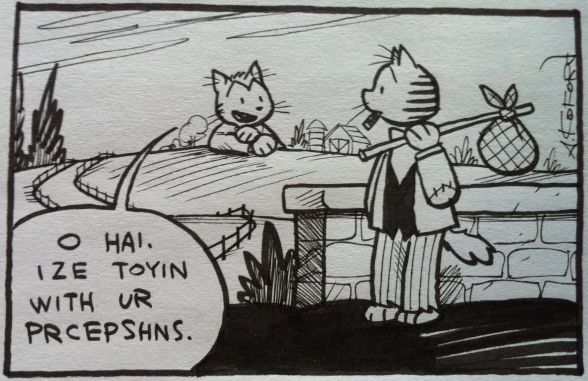N.B.: This post will almost certainly not help you play Connections; at most, it will give you my understanding of how the writers assign colors to categories.
The Question
I resisted playing NYT Connections for quite a while, but now I play it daily (yes, the NYT is awful; I do not pay them (I don’t even have an account, so no streaks and no history), and I block all their ads—and when the applicable content team was on strike, I did not cross the picket line). On Mastodon (and doubtless all the other socials), there is a hashtag community who post their daily scores, and I’ve started doing that, too. One thing I see with some frequency is “How is that [some color]? That was way too [hard/easy] for that!” I paraphrase, but it is not an unreasonable question. After all, the game claims that the categories’ colors are assigned from Purple (“Trickiest”) through Blue and Green to Yellow (“most straightforward”). And the game compliments you if you solve them in decreasing “trickiness.” But folks frequently see “harder” connections before “easier” ones. So what’s up with that? Since one of the things I claim to be good at is figuring out the underlying rule structures of things, I resolved to find out.
An Answer (sort of)
Just to get this out there: this “answer” does not work all the time. Hell, it might not even work most of the time—I only concocted it recently and can’t be arsed to track statistics, anyway. Whether the inconsistency is because the NYT writers don’t really have any rules or because I haven’t correctly divined them will likely remain a mystery for future generations. Nevertheless, I find it a useful approach, and a handy language for describing the kinds of categories.
It doesn’t say “easy” or “hard”
One of the first notions that went into my hypothetical construction is that the wording “Trickiest to most straightforward” a) is intentionally not “hardest to easiest”, and b) refers to the flavor of the connection rather than the challenge of solving it.
So let’s talk flavors
Here’s a puzzle:
And here’s the solution:
This is the archetype for my “answer”: The “most straightforward” category words are all just synonyms. And that is absolutely a straightforward connection. So if words are synonyms, they have a small-y yellow relationship (as distinct from being the big-Y Yellow category). Next, we have items that share a characteristic, so let’s call that a green relationship. Blue has always been the trickiest one for me to articulate. I mean, yes, in this case, they arguably have a green relationship because they share the characteristic of being common swag items, but to me, anyway, that relationship is quite a bit squishier than having a common delivery format. There are other relationships that I consider “bluer”, but it frequently comes down to not being purple or green. And again, sometimes everything is “yellow” and you just have to take a stab at which of the yellows is less yellow than the others. And again again, sometimes this just does not work. And I hate those days. Now to purple. Identifying a purple relationship is usually easy: if the thing connecting them is another word (“Shack”, in this case), or if you have to add or subtract letters to or from the words to get to the connection (recently, the Purple solution was “Luxe”, “Malt”, “Port”, and “Germ”, which are the beginnings of the names of European countries), that is a purple relationship.
I’m pretty sure I don’t want to know if the writers have criteria that they apply, but I’m pretty happy with this vocabulary, and have been using it for a few weeks now. Happy Connecting!


